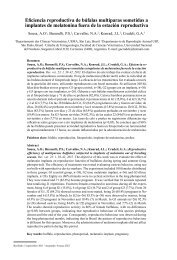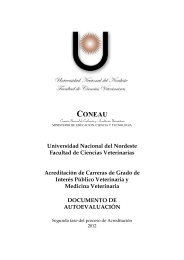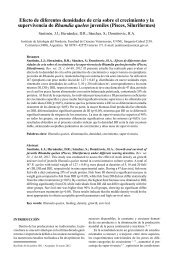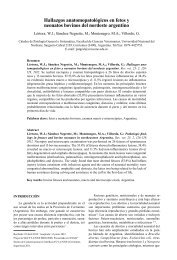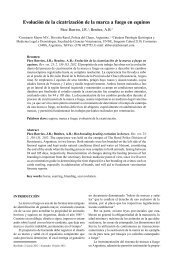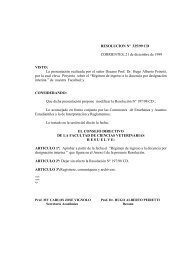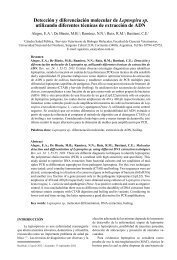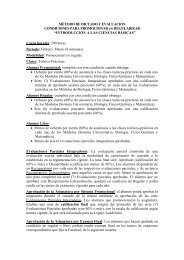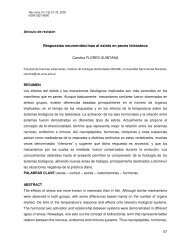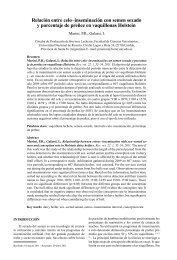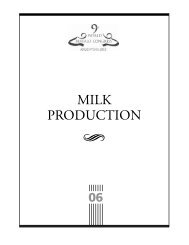REPRODUCTION - Facultad de Ciencias Veterinarias
REPRODUCTION - Facultad de Ciencias Veterinarias
REPRODUCTION - Facultad de Ciencias Veterinarias
Create successful ePaper yourself
Turn your PDF publications into a flip-book with our unique Google optimized e-Paper software.
<strong>REPRODUCTION</strong><br />
It also accomplished the thermal resistance test (quick TTR), where the sample is placed in a water bath at 46 º C for 30<br />
minutes to then be examined.<br />
Field Practices<br />
AI in buffaloes is an effectible reproductive biotechnology; however it requires the effective and continuous supervision<br />
of a Veterinarian with specific training in buffalo reproduction. Veterinary services must be offered as a task force. It is<br />
important to figure out that one of main constrain of the use of AI in buffaloes is the absence of Veterinary services and<br />
continuous supervision in the program. Thus, the main impediments to the use of AI in buffaloes in the Brazil as<br />
elsewhere in Latin America, at the present time are ina<strong>de</strong>quate nutrition, poor management and handling, a lack of<br />
rational breeding policies, and diseases (not necessarily all occurring simultaneous) and difficulty in liquid nitrogen<br />
supply. The AI in buffaloes as technology is quite feasible in Latin America condition and the fertility rates have achieved<br />
more than 80 per cent of conception rates, when used throughout correct technical criteria.<br />
CONCLUSION AND RECOMENDATION<br />
The AI in buffalo is a concern for each regional country and reflects the growing interest in the species as an important<br />
constituent of local agriculture and substantial contributor to country’s economy. The AI programme goes si<strong>de</strong> by si<strong>de</strong><br />
with improvement of the management, nutrition, diseases control with an overall impact on reproduction and milk /<br />
meat production. In some areas, the supply and cost of liquid nitrogen can limit the use of this technique. Moreover, it<br />
is the only alternative to avoid inbreeding which is affecting some buffalo breeds in this continent. The technology has<br />
unmistakable advantages for animal husbandry but unfortunately may be disadvantageous if used uncontrolled leading<br />
to inbreeding and lethal malformations. Thus, it is necessary to establish efforts to discuss such problems at international<br />
level in or<strong>de</strong>r to avoid the dissemination of many of these inheritance <strong>de</strong>fects. This biotechnology is quite feasible in<br />
buffaloes and the fertility rates have achieved more than 80 per cent of conception rates, when used throughout correct<br />
technical criteria. On this concern it seems that a wi<strong>de</strong> discussion among buffalo bree<strong>de</strong>rs and technicians should be<br />
established to find out a way to introduce “new blood” in the form of semen, from selected animals from India and<br />
Pakistan.<br />
Acknowledgements<br />
I would like to express my sincere gratitu<strong>de</strong> to: To Prof. Dr. José Seixas Lourenço, Dear of the Universida<strong>de</strong> Fe<strong>de</strong>ral do<br />
Oeste Paraense – UFOPA and FAPESPA – Fundação <strong>de</strong> Amparao e Desenvolvimento a Pesquisa do Estado do Pará, for the<br />
support provi<strong>de</strong>d. To Prof. Dr. Gustavo Cru<strong>de</strong>lli and Dr. Marco Zava for the kind invitation to participate of this meeting.<br />
REFERENCES<br />
Abdou, M.S.S., El-Guindi, M. .M., El-Menoufy, A.A. & Zaki, K. 1978. Enzymic profile of the semen of bovines (Bubalus bubalis and Bos taurus) . II.<br />
Parellelism between acid and alkaline phosphatases and various measures of semen quality. Zbl. Vet. Med., A , 25:222-230.<br />
Anand, S. R. 1979. Water buffalo: dilution and preservation of semen and artificial insemination. World Review Animal Production 15(4):51-55.<br />
Baruselli, P.S. & Vale, W.G. 2008. Inseminación artificial em La hembra bufalina. In:Palma. G. A. (Editor) Biotecnología <strong>de</strong> la reproducción, 2nd Ed.,<br />
Pugliese y Siena Publishers, p. 651-662.<br />
Basirov, E. B. 1964. Biology of reproduction and artificial inseminaton of buffaloes. 5th Inter. Cong. Anim. Reprod. and Art. Ins. Trento, 4:10.<br />
Bhattacharya, P. & Srivastava, P. N. 1955. Studies in <strong>de</strong>ep freezing of buffalo semen. 42nd Indian Science Cong., New Delhi, Vol. III.<br />
Bhosrekar, M. R. 1993. Studies on buffalo semen seasonal variation and effect of different diluents and freezing on sperm abnormalities. Indian Vet.<br />
Journal 58:784-789, 1993.<br />
Proceedings 9th Chaudhary , K. C. & Ganwar, P. C. 1977.Seasonal variations in physico-biochemical <strong>de</strong>terminants of buffalom (Bos bubalis) semen and their relation<br />
to fertility. Journal Agri. Science 89:273-277.<br />
854<br />
World Buffalo Congress



